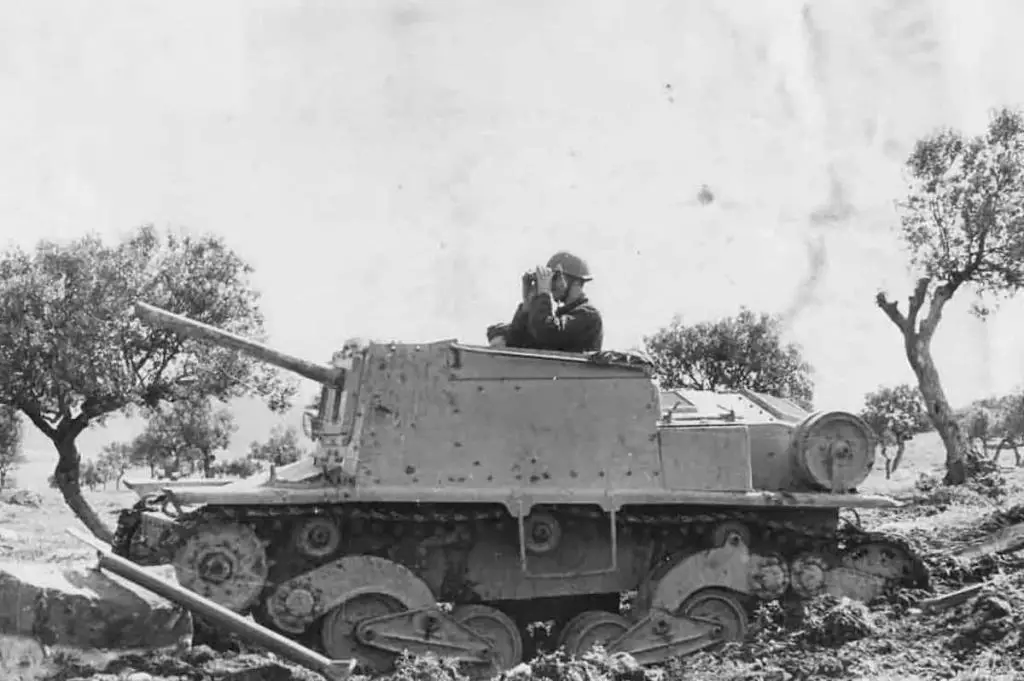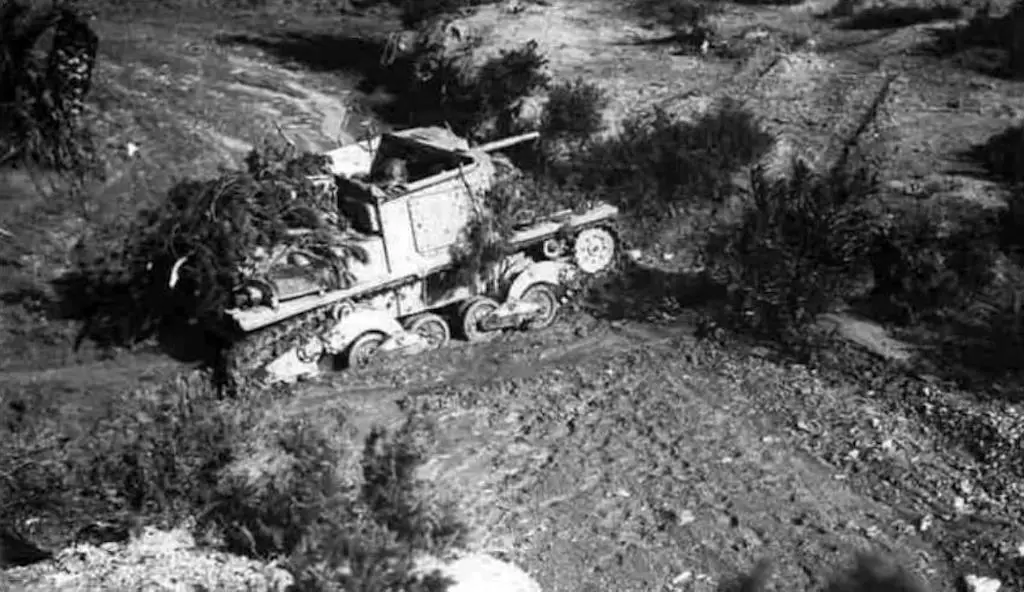Background on the Semovente L40 da 47/32
Throughout the Second World War, Italy suffered a shortage of effective armored fighting vehicles. Entering the war, the backbone of the Italian armored forces consisted of L3/35 tankettes. These vehicles were vulnerable to heavy machine-gun fire, and they lacked the armament to perform any role besides infantry support. The Regio Esercito quickly grasped their weaknesses in armored warfare, and steps were taken to mitigate them. One of these steps was the production of turretless tank destroyers, such as the Semovente L40 da 47/32.

A Semovente belonging to the II Gruppo of the Reggimento “Cavalleggeri di Lodi” (15º) in Tunisia.
First among these steps was the introduction of the L6/40 in May 1941 and the M series of heavier, cannon-armed tanks. One attempted solution which achieved mixed results was the Semovente da 47/32, which also began testing in May 1941. It utilized the light, affordable, and familiar L6/40 chassis. The removal of the turret simplified production and lowered the silhouette. Additionally, it utilized a rebored version of the plentiful Cannone da 47/32 mod. 1935. Fiat-Ansaldo increased the length from L/32 to L/40, offering improved armor penetration qualities. This Self Propelled Gun (SPG) entered service in 1942.

Second prototype of the Semovente da 47/32.
Often times, these introductions were a step too slow. As a stopgap more than anything, the M11 almost doesn’t bear consideration. Later, the M13 only saw widespread service for a year before being rendered obsolete. The Semovente l40 da 47/32 arrived, perhaps, a year late. Mounting an excellent gun for dealing with light tanks, armored cars, and cruiser tanks, it could have experienced great success in 1941. However, its 1942 introduction left it unable to cope with the new generation of Allied medium tanks.
Characteristics of the Semovente da 47/32
Being derived from a 6-ton chassis, the Semovente da 47/32 only weighed slightly more at 6.5 tons. The dimensions of the tank measured 3.82 meters in length, 1.86 meters in width, and 1.69 meters in height. Cutting such a small figure would be very favorable in combat, particularly in the mountainous confines of Italy. The crew consisted of three men, one commander, a driver, and a loader. It initially only carried two men, but such a small crew severely hampered combat efficiency.

Side view of the Semovente da 47/32.
The operational range reached its limit at 200 km. The 68 hp SPA 18 VT I4 petrol engine afforded reasonable performance, with an on-road speed of 42 km/h and an off-road speed of 25 km/h.
The armor of the vehicle was fairly light, with the thickest frontal armor measuring 30 mm. Side protection amounted only to 14.5 mm of armor. Additionally, the riveted armor subjected the crew to spalling should the armored shields take fire. While they enjoyed protection from small arms fire and some psychological benefit, that was all the armor provided. In practice, it was necessary for most tank destroyers to rely on their small frame to avoid enemy fire altogether.
The Semovente da 47/32 carried 70 rounds for its main armament, a rebored 47mm gun. It was capable of using armor-piercing rounds, with sufficient penetrative qualities to deal with anything lighter than a medium tank. Additionally, the high explosive round offered some usefulness in the infantry support role. It also carried an ‘effeto pronto’ HESH round, which was capable of killing M3 and M4 medium tanks at short combat ranges.
Variants
Besides the standard version, two variants existed. First, the ‘Carro Comando Plotone per Semovente da 47/32’, a platoon commander vehicle. While ammunition capacity saw a reduction to 47 rounds, it carried a Marelli RF 1 CA radio set. Second, the company commander vehicle, the ‘Carro Comando Compagnia per Semovente da 47/32’. In production, a mockup took the place of the genuine 47mm gun. The extra space made room for two radio sets, and a single 8mm machine gun for personal defense. The standard Semovente da 47/32, however, did not mount a radio.
Combat history
Much of the initial production of the Semovente da 47/32 was sent to the Italian forces in Russia. It was sought to bolster the anti-tank firepower of the Italian forces which possessed no medium tanks. While the Red Army still employed many light tanks, the increasingly prolific T-34 was near-impervious to the Semovente L40 da 47/32. Regardless, no weapon would have saved the thin lines of the Armata Italiana in Russia. During the winter of 1942-1943, they bore much of the tremendous Soviet offensive effort. Of the 80 Semovente models dispatched there, the Red Army destroyed most in Operation Uranus and Operation Little Saturn.

A Semovente L40 camouflaged with branches and shrubs.
Against the Allies, some served in North Africa and Sicily. After the fall of Sicily and the Italian-Allied armistice, the Germans appropriated every available 47/32 SPG. Some passed into their own use, and others fell to their puppet state in Croatia or Mussolini’s new Italian Social Republic. As they were near-obsolete by 1943, employing them in anti-partisan actions was common.

Semovente L40 da 47/32 of the 14.Pol.Pz.Kp with a modified superstructure in Slovenia, 1944.
In all, Italy produced 282-320 units of the 47mm-armed gun carriage. They saw little to no use or interest post-war, and one may assume that few survive to this day. One unit can currently be found at the U.S. Army Ordnance Museum in Aberdeen Proving Ground, Maryland.
Specifications
| Model | Semovente da 47/32 |
|---|---|
| Crew | 3 Commander, Driver and Loader |
| Horizontal Traverse | 27° |
| Vertical Traverse | -12° to +20° |
| Rounds | 70 |
| Muzzle Velocity | 630 m/s AP shell 250 m/s HE shell |
| Firing Range | 7,655 ft (7,000 m) |
| Length | 12' 4.9" (3,782 m) |
| Width | 6.1 ft (1.86 m) |
| Height | 5.5 ft (1.676 m) |
| Powerplant | SPA 18 VT I4 petrol engine 68 HP |
| Speed | 25-42 km/h |
| Armor | 30 mm/Front 14.5 mm/Sides |
| Armament | 47 mm Cannone da 47/32 |
| Weight | 6.5 tons (14,000 lbs) |